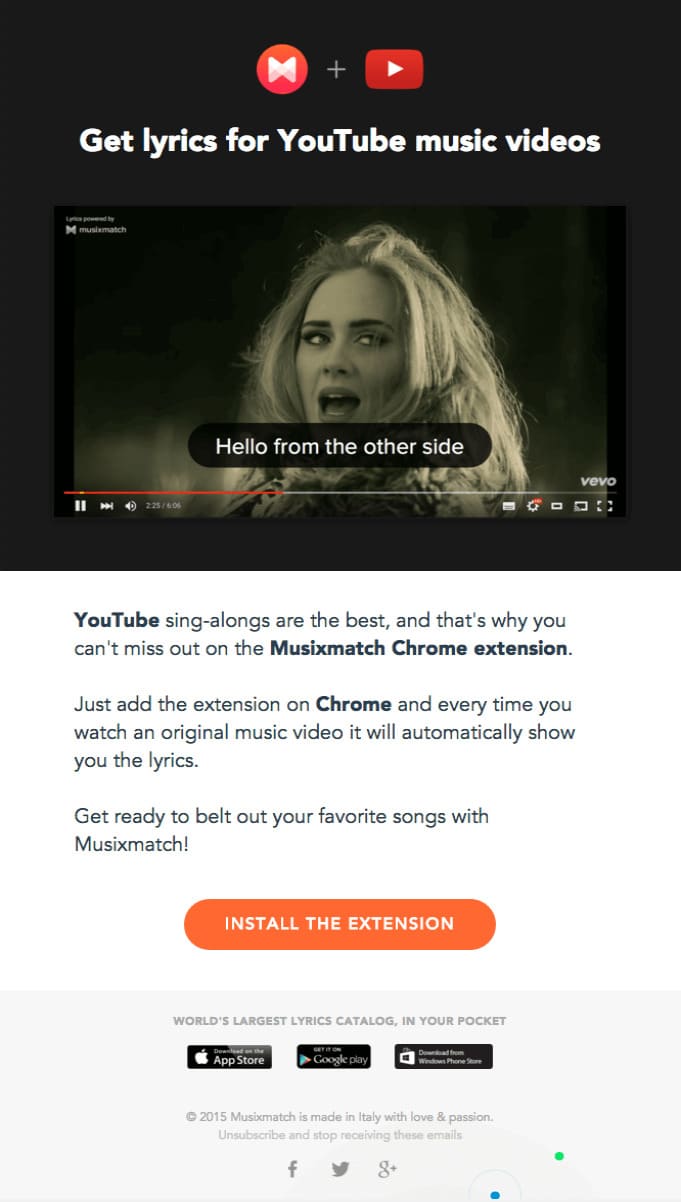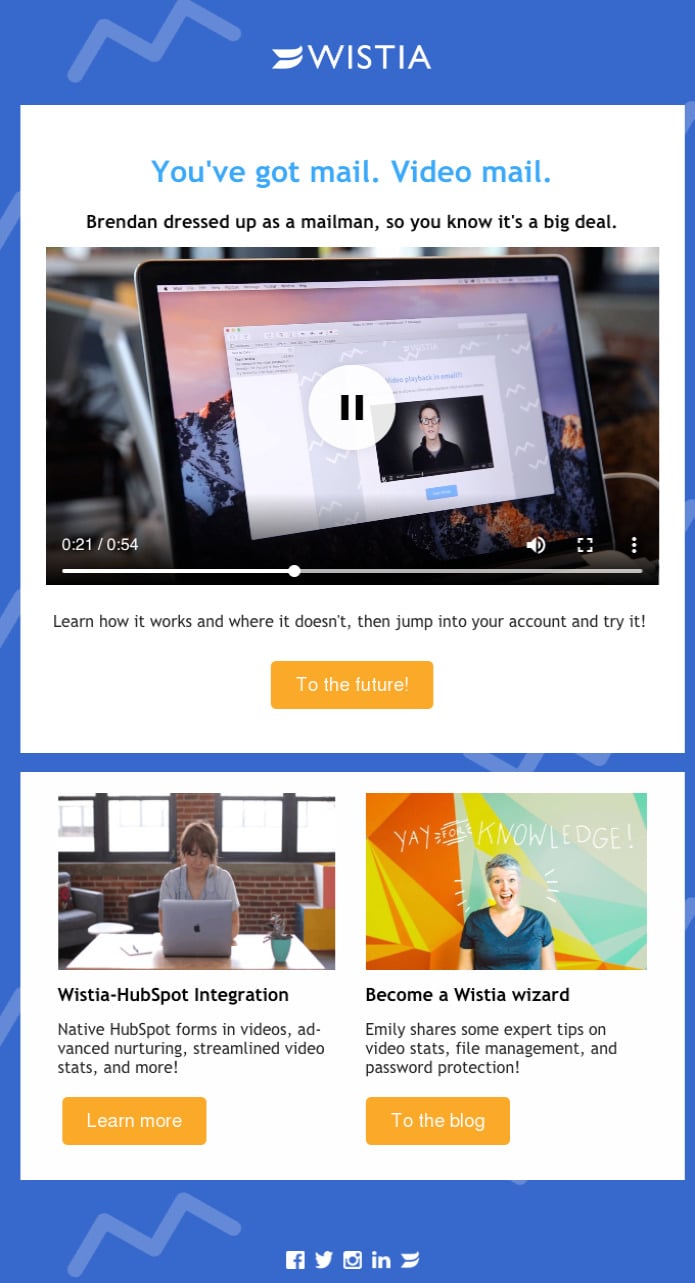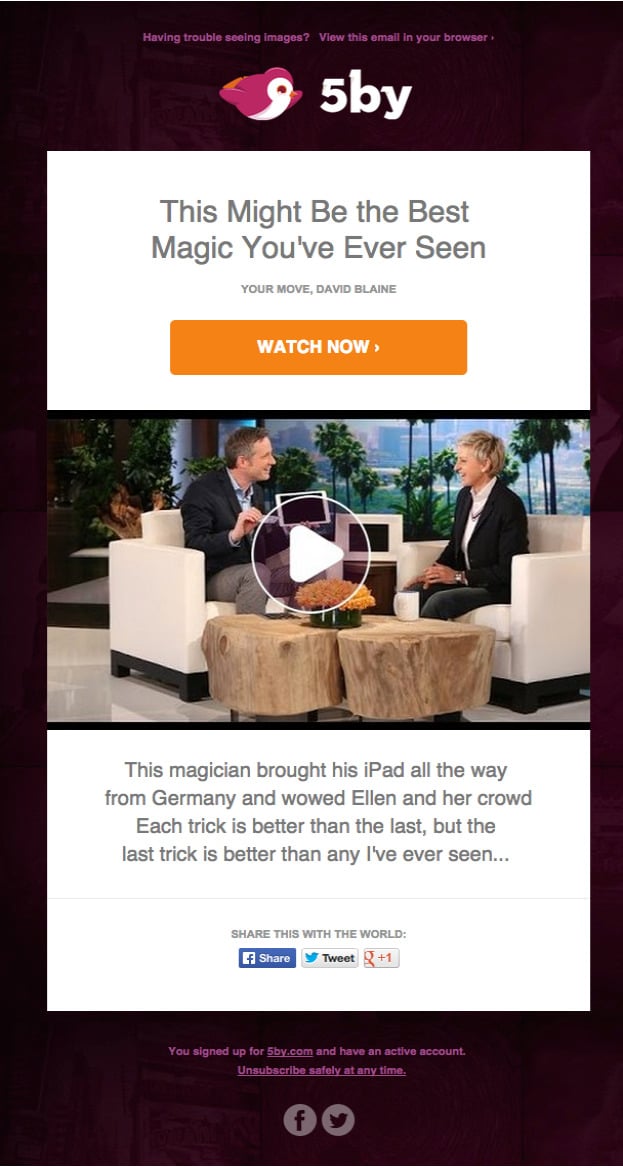5 best practices for using video in your email marketing
Video killed the radio star, and now it’s aiming to take over digital marketing.
Cisco’s Visual Networking Index predicts that video will comprise 80% of internet traffic by the year 2021, with over 1.9 billion videos flooding online channels.
That’s because video is the perfect vehicle for creating engagement and providing customers with authenticity—a relationship that also boosts trust and sales.
With this kind of power, leveraging this channel for your email marketing campaign is a no-brainer. And, with our actionable tips, it’s also a cinch to implement.
Let’s start by discovering a few of the many benefits of using video in email marketing.
The benefits of video in email marketing
Using video in email marketing allows you to get closer to your customer. In fact, placing the word “video” in your email subject line can increase click-through rates up to 40%.
Additionally, video provides your customers with compelling reasons to buy in a creative, relatable way where they don’t feel overwhelmed by information.
In fact, video can take 1,800,000 words of explanation and fit it into one short minute—a perfect way to grab the attention of time-stressed buyers without overwhelming them.
Video definitely intrigues prospective buyers. In fact, statistics show that it can improve your email marketing ROI by reducing unsubscribes by 26% and increasing click-through rates by 200-300% when used in an email.
Video hub Youtube even uses email to announce their newest features:
Image: Really Good Emails
On top of all that, videos contribute to a higher ranking with search engines, in part due to the high level of social sharing that occurs.
With those kinds of compelling results, marketers are flocking to video to boost email campaign results. So, let’s look at how you can leverage video in your email marketing strategy.
Making video work for you
Video isn’t just a one-trick pony—there are many ways to use the power of this channel to increase engagement, conversions, and revenue in your campaign. But first, you’ll need to make some choices.
1. Choose your video type.
There are numerous video types to consider when choosing the right one for your email campaign. Here’s a list of some of the most commonly used:
- Live videos
- Brand videos
- Event videos
- Demo videos
- Educational/tutorial videos
- Case study/testimonial videos
- Animated videos
You’ll need to determine which of these fits your brand’s personality—and product or service—the best.
Some have distinct advantages over others. For example, live video gets viewers riveted longer than on-demand types, and more than 80% of people would rather see a live video than a social or blog post.
GoPro has mastered the art of live video and combined it with user-generated content for an extra punch of effectiveness: Watch the video here.
And if you have something to demonstrate, video is perfect since 4 times as many people would rather watch a video demo than read about your product.
If you need to build trust and social proof, consider providing customer testimonials through video.
As Neilson research reveals, 92% of people trust recommendations from people they know—and people they don’t.
See a preview of a video email campaign that Wistia sent to their subscribers below:
Image: Really Good Emails
2. Ready to create? Begin with a plan.
Once you’ve determined your video type, it’s time to get your marketing team together and sort out the details. Here’s a quick checklist you can use to start the ball rolling.
- Who are you targeting?
- Is this part of your audience or all of it?
- What action do you want your viewers to take after they’ve watched the video?
- What’s the budget and timeline?
- Who are the creative professionals you need to draw into your team? Graphics designers? Video professionals?
- How will you measure the success of your video?
These are just basic suggestions—your team may have a more specific plan in place as part of a larger marketing strategy.
Email marketing lends itself to any marketing strategy and video is a good fit not only in emails, but also on landing pages and social channels as well.
Continuity across channels can assist in giving continuity to your brand and providing clear expectations for customers.
So, once you’ve set up an outline of your overall goals, it’s time for the next exciting step: scripting and shooting your video.
3. Write the script, practice it, then shoot and edit.
Words on a page sound different when they’re read aloud, so be sure to write a script for your video and practice it several times before filming to save time, money, and effort.
A good script will include the following:
- A compelling hook
- A single overall message
- Context and narrative
- Call-to-action
It’ll also include more words than you need, at least initially, so be prepared to edit, edit, edit.
Make sure your tone fits with your brand’s personality and your audience’s expectations and put your message front-and-center in the first 30 seconds of the video.
And filming? Don’t think you have to hire a full-on production crew. Your iPhone (or any smartphone) can do a great job.
In fact, Kate Hudson filmed about 70% of the video for her clothing line, Fabletics, from her iPhone. Not only does this save money, but it also gives your viewers that authentic feel they’ve been looking for as a bonus. See the video here.
After you’re finished shooting, make sure to have several pairs of eyes review the video for content, effectiveness, and quality. After all, this video is representing your business and you want it to be outstanding.
There’s plenty of easy-to-use free video editing software for you to try if you’re on a budget. Otherwise, your video production team will be the go-to for final editing and sampling of the final product.
4. Focus: The Call-to-action
Your call-to-action (CTA) is the centerpieces of your video in email marketing, so make it count. It should be short, clear, and actionable.
Fortunately, today’s technology allows you to embed contact forms directly into your video or include CTAs that pop out during video play. Here are a few ways you can direct your audience’s attention:
- Offer a free trial: This is the perfect option for businesses with subscription-based services.
- Ask for feedback: Let viewers take a simple poll or survey to get engagement and valuable marketing feedback.
- Create a sign-up form: If you have a webinar or other event in your timeline, allow sign-ups through your email by using this CTA.
- Encourage sharing: Let viewers engage with your brand’s on Facebook, Twitter, or YouTube or a use a hashtag dedicated to this campaign.
- Host a contest: Generate engagement and grow your list by offering a simple contest or giveaway.
- Link to other videos: Start with a short video, then invite them further into your funnel with more targeted snackable content featuring your business.
There are plenty of other ways to engage and convert, so choose the one that fits your marketing goals best.
5by sent this email with the subject line "If you watch one video this weekend, make it this one."
Image: Really Good Emails
5. Measuring success
You’ve done your homework, created a compelling video, and sent it out via email. Now, you’ll want to measure the results.
Of course, you’ll use your initial marketing goals to zero in on the critical metrics, but here are a handful of statistics you can include in your measurements for even more confirmation of effectiveness:
- Click-through rate: How many viewers clicked through to follow your CTA
- View count: The number of times your video has been viewed
- Play rate: How many viewers clicked on “play” and started to watch
- Conversion rate: How many viewers acted on your CTA after a click-through
- Social sharing: How many times viewers shared your video
- Engagement: How much of your video viewers watched after clicking play
- Feedback: Comments on your video (can be combined with social sharing)
You can measure any, or all, of these metrics to give you a clear view of how effectively your video is accomplishing your marketing goals.
If your video is underperforming in some areas, these metrics target where you can make adjustments.
Wrap up
Using video in email marketing is a powerful tool for achieving your campaign goals.
With its authentic, personal nature, it can drive engagement and its flexibility allows you to switch tactics as your customers’ touch points change.
Best of all, you don’t need expensive technology to make it work for you. Even celebrity brands like Fabletics are shooting high-converting videos on simple smartphones.
With more brands leveraging this cutting-edge tactic for marketing success, you’ll want to get moving on your own series of email videos to keep on-trend — and keep your revenue flowing.
MOST RECENT ARTICLES
Want to engage your audience and grow your brand? Try Emma's robust easy-to-use product today.
















